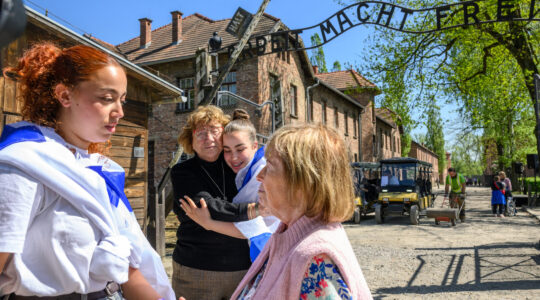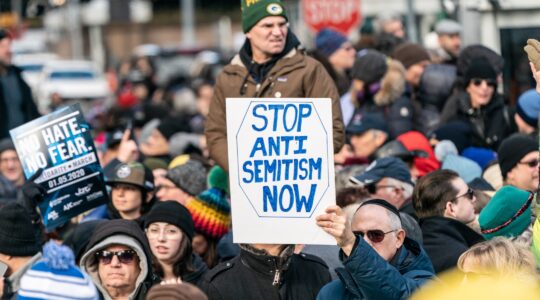SHARGOROD, Ukraine (JTA) – Down this town’s main road, just off a square shared by a Catholic church and an Orthodox monastery, sits a cluster of dilapidated wooden homes – a pearl of Shargorod’s Jewish past.
The largest such cluster in southern Ukraine, these houses once were the heart of rural shtetl life in the 19th century Pale of Settlement.
Far from the Ukrainian capital, along rutted country roads that crisscross this former breadbasket of the Soviet Union, the historic region of Podolia is a reminder that the Jewish presence here lives on even as few Jews remain.
“In our minds we think this world is lost,” says Valery Dymshits, a Jewish folkloric scholar with the Petersburg Judaica Center in Russia. “But we can say that parts of this world still exist.”
Podolia, an area stretching southwest of Kiev and up to the famed Dniester River along the border with Moldova, today offers more than a whiff of that bygone era.
Along with the quaint homes there are fortress-style synagogues, ornate cemeteries with headstones of ballplaying lions, and shrines to revered Chasidic figures like the Baal Shem Tov and Rabbi Nachman of Breslav.
In Mogilev-Podolsky, dubbed by some “the last Jewish city in the Soviet Union,” locals say Yiddish was spoken on the streets as recently as 20 years ago. And in the city of Vinnitsa, the downtown neighborhood nicknamed Yerusalimka – “Little Jerusalem” – is a daily reminder of how prominent the Jews here once were.
But nowhere is more striking than Shargorod, where the homes in the Jewish neighborhood lay virtually untouched over the past century. Most are the same ramshackle structures constructed from a combination of wood, stone, mud and thatch.
Shargorod also has the oldest stone synagogue in Ukraine, dating from 1589. Its massive, 3-foot-thick walls and pointed crenellations comprised part of the town’s military defenses before the Soviets converted it into a juice factory. The sanctuary entrance has been replaced by enormous stained barrels plugged with tubes.
Still, in drowsy Shargorod, it doesn’t take much imagination to conjure up the Jewish life that Sholom Aleichem etched in his touching tales.
“Every home has a story,” says Bella Garbar, one of 30 Jews who live in the town today. “But almost no one stayed, which is a tragedy for the Jewish people.”
Indeed, the Podolian Jewish exodus to Israel, the United States and Germany that followed the disintegration of the Soviet Union continues to be felt as profoundly here as in other smaller Jewish communities across this erstwhile empire.
For the Jews of Podolia, it’s the latest in a long line of body blows.
From the murderous rampage of 1648, when Bogdan Khmelnytsky’s Cossacks wiped out tens of thousands of Jews and their communities, to the sporadic pogroms of the 19th and early 20th century, Podolia’s Jews have faced tough odds.
But with its historical capital in Kamenetz-Podolsky, Podolia remained heavily Jewish through the 1930s despite Stalin’s purges. The Soviet authorities tolerated Jewish farming collectives, Yiddish-language schools, theaters and newspapers.
In Vinnitsa, local birth certificates were issued in Yiddish – even to non-Jewish Ukrainians, according to local Jewish community member Igor Desner.
Desner said he learned of this years ago when a local Ukrainian approached him with his mother’s prewar birth certificate wondering if the Yiddish on it meant she was a Jew and thus qualified to receive Jewish welfare assistance and possibly to emigrate.
In Mogilev-Podolsky, Jewish community chairman Leonid Brechman, 67, recalls that Yiddish was so pervasive during his childhood that when a neighbor married a Ukrainian woman, her son soon “spoke better Yiddish than some of the Jewish kids.”
The turning point for Podolia came a few years after Nazi death squads swept through here, filling the forests with Jewish corpses.
In late 1952, Stalin unleashed the so-called Doctor’s Plot, accusing a ring of doctors – most of whom happened to be Jews – of trying to poison him. The ensuing frenzy terrified the Jews. Many stopped speaking Yiddish in public; others stopped speaking it at home.
Gradually one of the community’s most distinctive features withered.
The most devastating blow, however, came with freedom when in the early 1990s hundreds of thousands of Jews in this ex-Soviet republic fled the grim, largely lawless hardship of this area.
In Mogilev-Podolsky, some 10 to 15 families left each day, whittling down the community to just 350 today from some 9,000 in 1990.
Some elderly and a few others stayed behind.
The future of Jewish life appeared so bleak to community leaders that not long ago a community president sold the century-old synagogue here to a Seventh-day Adventist Church. Today the community’s president says he regrets that decision.
In Vinnitsa, a former synagogue has become a furniture store, the buffed brass railing of the spiral staircase up to the balcony now a shimmering accoutrement to the gaudy decor.
Behind a busy city boulevard in the leafy Yerusalimka district, a few of the homes are still occupied by Jews. One home with a small, turret-like corner room overhanging the sidewalk has a removable roof; the Jewish tenants used to detach it to build their sukkah on Sukkot.
Even though Ukraine remains the site of occasionally ferocious anti-Semitism – this summer, a Chabad rabbi and his wife were beaten on a street in nearby Zhitomir, a historic center of Jewish life – some Jews here suggest neighbors are more in awe of Jews.
Some are impressed that Jews from around the world send Jews here food parcels and other aid.
Others attribute rare healing powers to Jews. In Vinnitsa, the synagogue receives special requests for healing about once a week. Ukrainians in trouble seem to feel that if the money they give their church doesn’t help, maybe the synagogue can.
“If the problem remains, they approach our synagogue to request a prayer,” says Isaak Novoseletskiy, chairman of the Vinnitsa City Jewish Religious Community. “The priest tells them ‘the Jewish prayer reaches God’s ear faster than any other.’ ”
When an elderly Ukrainian woman comes to the synagogue to ask for a prayer that her neighbor should “stop ruining my life,” Novoseletskiy is ambivalent. He says he knows Jews should pray only for a person’s good health, not for someone else’s ill health, but there’s a reason he agrees to recite the person’s name during prayers.
“If I refuse, they could later say, ‘Ah, the Jews refused to pray for our good health,’ ” Novoseletskiy says. “And I believe the behavior of one Jew is then projected onto all Jews.”
Despite their small numbers, the pulse of Jewish life continues to beat in Podolia.
In Mogilev-Podolsky, a circle of 15 to 20 Jewish men aged 50 to 90 gathers every evening to pray and chat at the last remaining synagogue in town, converted from a private residence not long ago.
In Vinnitsa, Novoseletskiy is proud of his refurbished synagogue, a Soviet-era theater that after a battle and some looting was returned to the Jewish community 15 years ago. Today the sanctuary has a new wooden, hand-carved ark, and there is a new mikvah in the basement.
And in Shargorod, the last 30 Jews in town formed their own official community this summer. Solidarity was just one reason, Bella Garbar says.
“We also need to be a recognized community,” she says, “to have our synagogue restituted back to us.”
JTA has documented Jewish history in real-time for over a century. Keep our journalism strong by joining us in supporting independent, award-winning reporting.





